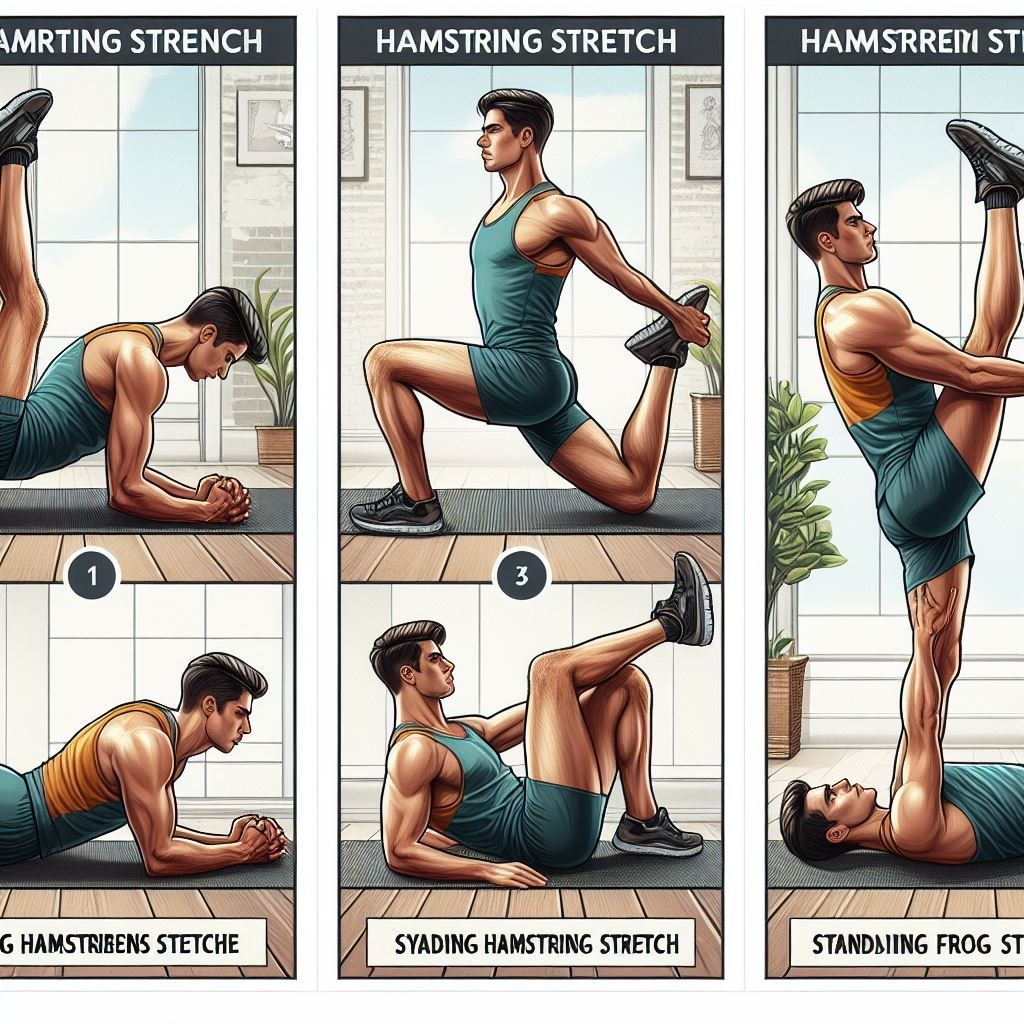Hamstring exercises are essential for building strength and flexibility in the posterior chain. The hamstrings are triple muscles located at the back of the thigh that work together to flex the knee and extend the hip. Targeting the hamstrings with focused exercises can improve athletic performance, prevent injury, and alleviate chronic tightness and pain.
This comprehensive guide will outline the top 12 hamstring exercises to add to your training routine. These movements target the hamstrings from multiple angles to ensure complete muscle development. We will also provide form and technique cues, workout suggestions, and injury prevention tips. Read on to learn how to unleash the full potential of your hamstrings!
Key Takeaways for the Best Hamstring Exercises
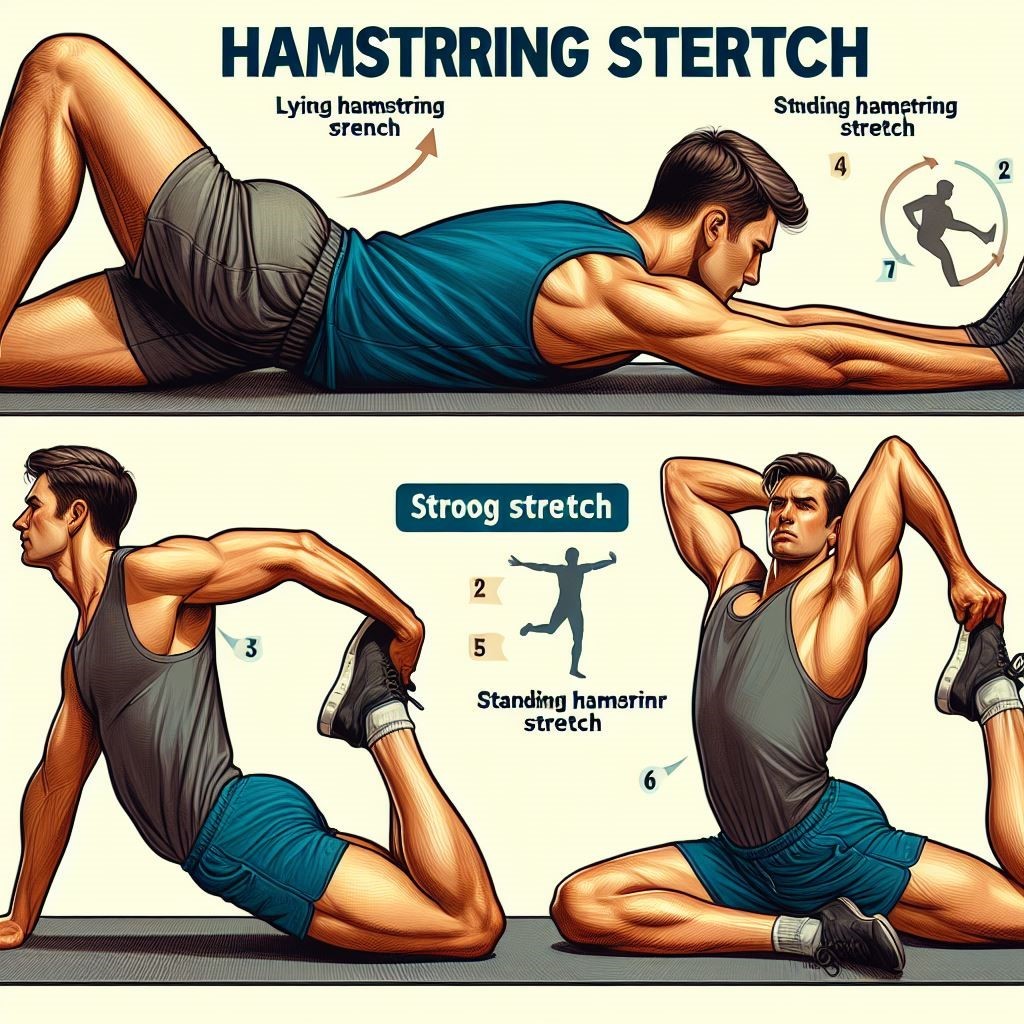
Before diving into the top 12 exercises, here is a quick overview of the key points:
- Train the hamstrings 2-3 times per week for optimal results
- Perform a mixture of hip extension, knee flexion, and knee extension hamstring exercises
- Focus on eccentrics to build strength and flexibility
- Moderate weight for 8-12 reps is ideal for hypertrophy
- Increase load and lower reps for strength; higher reps for endurance
- Warm up properly and progress loads gradually to avoid injury
- Listen to your body and rest if you experience pain or tightness
Hamstring Exercises Benefits
Performing focused hamstring exercises offers many benefits beyond just bigger, stronger hamstrings. Here are some of the top reasons for incorporating hamstring training:
- Improves posture – Strong hamstrings combat the effects of prolonged sitting. They help maintain proper pelvic alignment and reduce lower back pain.
- Prevents knee and ACL injuries – The hamstrings play a crucial role in stabilizing the knee joint. Strong hamstrings reduce stress on the ACL and keep the knees stable.
- Enhances athletic performance – Sports like sprinting, jumping, and kicking all rely on hamstring power. Strengthening them boosts speed and explosiveness.
- Increases flexibility – Consistent hamstring training lengthens the muscle and improves the range of motion. This makes daily movement easier and prevents injuries.
- Activates glutes – The hamstrings work synergistically with the glutes. Targeting them facilitates better glute activation during hip extension.
- Balances the lower body – Building the hamstrings balances the strength between the quadriceps. This improves posture and movement mechanics.
- Alleviates low back pain – Tight hamstrings contribute significantly to low back issues. Stretching and strengthening them reduces pain and discomfort.
- Speeds recovery – The hamstrings are prone to strains and tears. Proper training keeps them supple and less injury-prone.
In summary, diligently training the hamstrings pays dividends through increased performance, improved mechanics, pain, and injury prevention, and better overall functional movement.
Hamstring Exercises Tips
Here are some tips for getting the most out of your hamstring workout:
- Warm up thoroughly Spend 5-10 minutes warming up before training hamstrings. Foam rolling, dynamic stretches, and bodyweight moves prepare them for exercise.
- Mind the eccentric – Emphasize reps’ eccentric or lowering portion to maximize strength gains. Perform the eccentric for a 2 count.
- Use a full ROM – Ensure you lower the weight through a full range of motion to lengthen the hamstring fibers. Avoid partial reps.
- Vary foot position – Changing foot stance hits the hamstrings from different angles. Try wide, narrow, angled, and unilateral stances.
- Monitor knee position – Keep knees slightly bent during hip hinge exercises. Do not lock them out fully.
- Prevent back rounding – Maintain a flat back during exercises. Do not round the spine; this shifts stress to the lower back.
- Control the descent – Lower the weights slowly and with control. Do not dump the load at the bottom.
- Rest completely Allow at least 48 hours between intense hamstring sessions. The muscles need time to recover and strengthen.
Properly warming up, using the form, and resting sufficiently will help you train your hamstrings effectively while avoiding injury.
Top 12 Hamstring Exercises
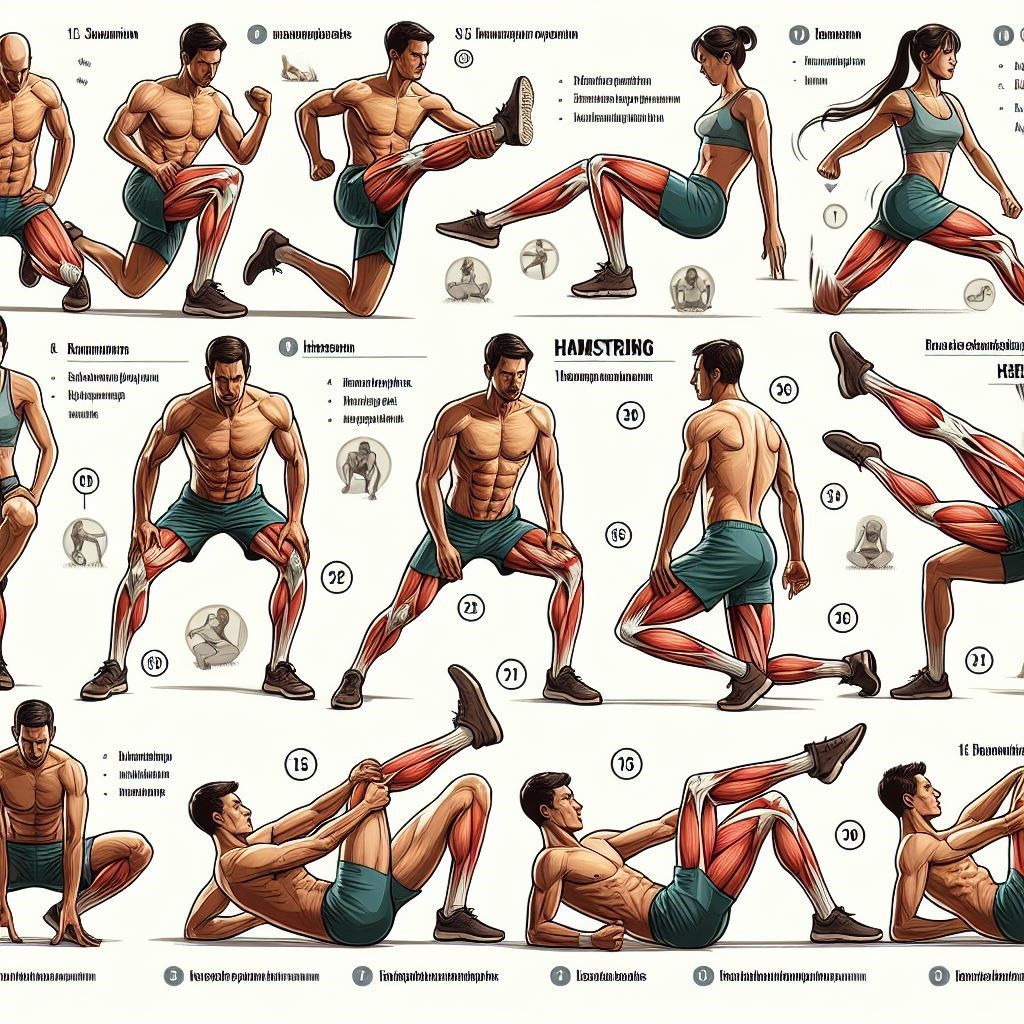
Now let’s get to the hamstring exercises!
-
Romanian Deadlift

The Romanian deadlift (RDL) is a hip hinge movement that targets the entire posterior chain. It is one of the most effective hamstring exercises.
How to perform the Romanian deadlift hamstring exercises:
- Stand tall with feet hip-width apart, holding a barbell or dumbbell
- Hinge at the hips by pushing your hips back as if closing a door behind you
- Descend as far as flexibility allows while keeping a neutral spine
- Squeeze the hamstrings to return to standing
Form tips for the Romanian deadlift hamstring exercises:
- Maintain a flat back; do not round the spine
- Keep your shoulders retracted and down throughout
- Lightly bend the knees; do not lock them out
- Feel a stretch in the hamstrings at the bottom
- Exhale at the top; inhale at the bottom
The RDL puts significant tension on the hamstrings through a deep range of motion. Go slowly on the descent and control the weight. Perform 2-4 sets of 8-12 reps of these effective hamstring exercises.
-
Seated Leg Curl

The seated leg curl primarily targets the short head of the biceps femoris. This isolation hamstring exercise is done on a leg curl machine.
How to perform the seated leg curl hamstring exercises:
- Sit on a leg curl machine with legs under the pad
- Keep feet together, knees aligned with hips
- Initiate the movement by flexing from the knees
- Curl legs up as far as possible without lifting the hips
- Slowly lower back down, just short of straightening the knees fully
Form tips for the seated leg curl hamstring exercises:
- Adjust the pad to rest on the Achilles tendon
- Sit upright throughout the set; do not slouch
- Avoid swinging the torso or using momentum
- Squeeze the hamstrings and hold for 1 second at the top
- Control the descent for a full range of motion
Aim for higher reps like 3 sets of 10-15 to maximize time under tension. The strict form of this hamstring exercise provides an intense hamstring burn!
-
Good Morning

This free-weight hamstring exercise develops hamstring and glute strength for improved hip extension. The morning is a staple compound lift.
How to perform the good morning hamstring exercises:
- Stand with feet hip-width apart, holding a barbell across the traps
- Initiate the movement by hinging at the hips and sticking your glutes back
- Keep the spine neutral as you bend forward at the waist
- Go down as far as you can while maintaining a flat back
- Drive through the hips, glutes, and hamstrings to return to standing
Form tips for the good morning hamstring exercises:
- Maintain full body tension and a stable core
- Keep the knees slightly bent but do not squat
- Do not round the back; focus on hinging through the hips
- Breathe out as you descend and inhale as you rise
- Start with no weight or a dowel to reinforce proper form
Perform 2-3 sets of 6-10 reps using a challenging but manageable weight. This multi-joint hamstring exercise recruits the posterior chain.
-
Glute Bridge
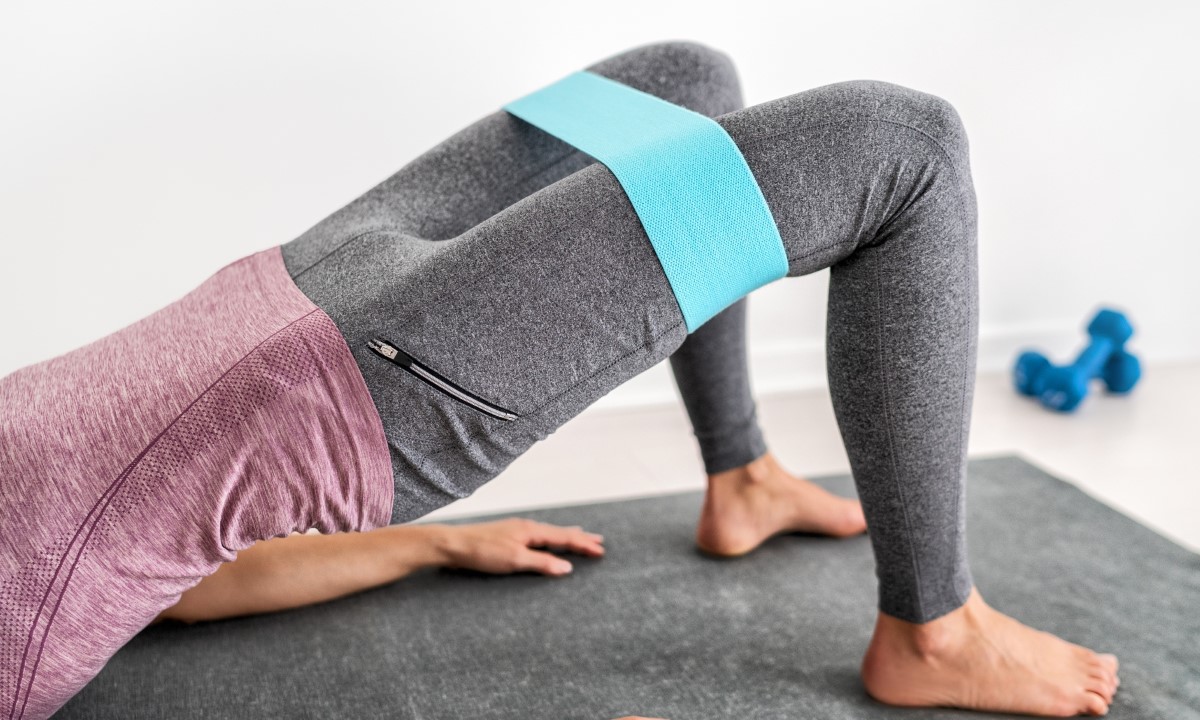
The glute bridge effectively trains the hamstrings while focusing on the glutes. These hamstring exercises build full hip extension strength.
How to perform the glute bridge hamstring exercises:
- Lie face up on the floor with knees bent at 90 degrees
- Place your arms at your sides with palms facing down
- Drive through the heels and squeeze the glutes to lift the hips up
- Raise as high as possible, forming a straight line from knees to shoulders
- Hold briefly at the top, then slowly lower back down
Form tips for the glute bridge hamstring exercises:
- Keep the core engaged to maintain a neutral spine
- Do not drive through the toes; keep pressure on the heels
- Lift the hips until the thighs are parallel to the floor
- Focus on using the glutes and hamstrings to extend the hips
- Exhale at the top, inhale on the descent
Aim for sets of 10-15 reps. For more difficulty, perform single-leg glute bridges.
-
Side Out

The slide-out effectively isolates the hamstrings with very little equipment required. All you need is a slick surface like a wood floor or a slide board.
How to perform the slide-out hamstring exercises:
- Sit tall on the floor with legs straight out front
- Place your hands slightly behind your hips with fingers facing behind you
- Keeping the legs straight, engage the hamstrings to slide the feet out
- Slide until you feel a stretch in the hamstrings
- Use the hamstrings to pull your feet back to the starting position
Form tips for the slide-out hamstring exercises:
- Maintain an upright posture and engage the core
- Avoid rounding the lower back
- Keep legs straight, and feet flexed
- Focus on controlling the slide-out and pulling back
- Breathe out, slide away, inhale, slide in
Shoot for 2-3 sets of 15-20 reps. The long range of motion provides an intense hamstring exercise challenge!
-
Single Leg Deadlift
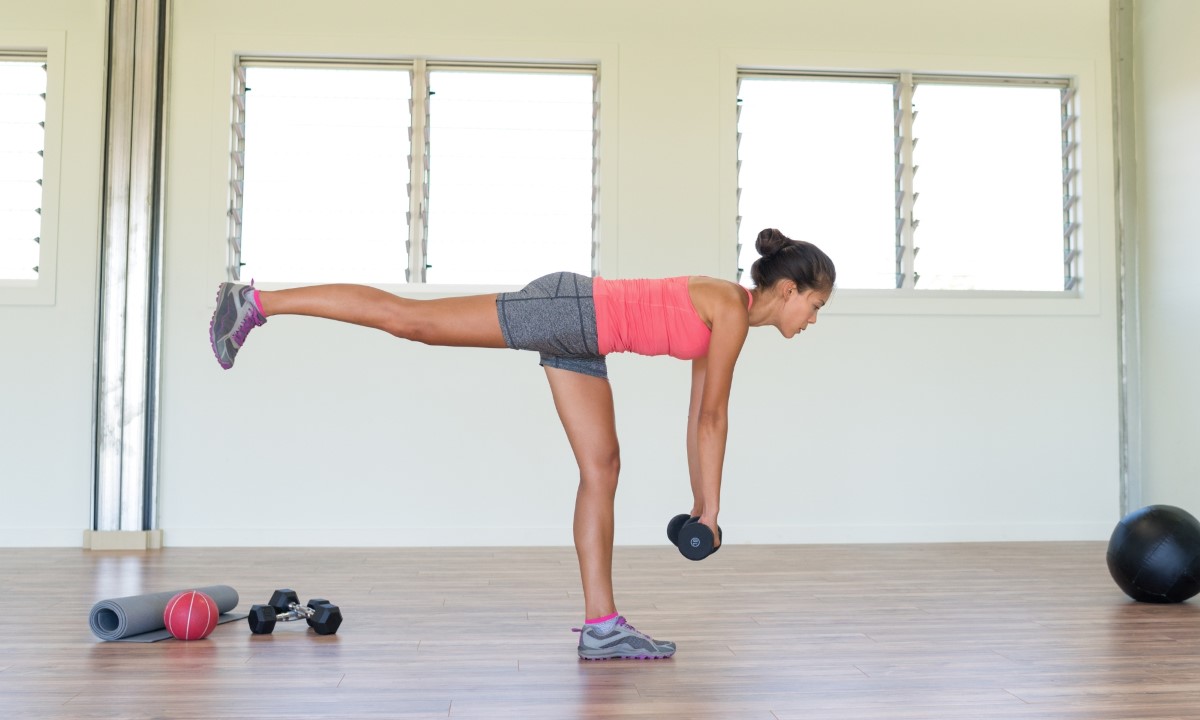
This unilateral hamstring exercises improves hamstring and glute strength while challenging your balance and core stability.
How to perform the single-leg deadlift hamstring exercises:
- Stand on one leg, maintaining a tight core and neutral spine
- Hinge at the hips, push your butt back and extend your free leg behind you
- Go down until you feel a stretch in your hamstrings
- Squeeze the glutes and hamstrings to return to the starting position
- Complete all reps on one side, then switch
Form tips for the single-leg deadlift hamstring exercises:
- Maintain a flat back throughout the movement
- Keep the standing knee slightly bent
- Raise the non-standing leg straight back
- Avoid leaning or rotating the torso
- Use a light dumbbell for added challenge
Shoot for 3 sets of 8-10 reps per side. This challenging unilateral move requires balance and coordination.
-
Nordic Hamstring Curl

The Nordic hamstring curl is performed on the floor to build eccentric hamstring strength. It provides intense hamstring exercises for the entire posterior chain.
How to perform the Nordic hamstring curl exercises:
- Kneel on the floor with your torso upright and knees bent at 90 degrees
- Plant your feet under a stable support or have a partner hold them
- Keeping the hips and core engaged, slowly lower into a face-down position
- Use eccentric hamstring strength to control the descent
- Push through the glutes and hamstrings to return to the starting position
Form tips for the Nordic hamstring curl exercises:
- Maintain a neutral spine and straight line from head to knees
- Descend slowly under control for 4-6 seconds
- Keep hips square and steady throughout the movement
- Bend from the knees, not the waist
- Use a towel under the knees for padding if needed
Build eccentric strength with 3-5 reps of slow and controlled descents. The Nordic curl intensely works the hamstrings!
-
Kettlebell Swings

This explosive total-body hamstring exercise recruits the hamstrings along with the posterior chain. Kettlebell swings build a powerful hip extension.
How to perform the kettlebell swing hamstring exercises:
- Hold the kettlebell with both hands in front of your body
- Hinge at the hips to swing the kettlebell back between your legs
- Thrust your hips forward and swing the kettlebell up to chest height
- Control the descent as you swing the kettlebell back through your legs
Form tips for the kettlebell swing hamstring exercise:
- Maintain a neutral spine; do not round your back
- Generate power from the hips and glutes, not the arms
- Use a hip hinge; do not squat down
- Keep the shoulders back and neck straight
- Exhale at the top, inhale at the bottom
Perform 2-3 sets of 10-15 reps. This ballistic hamstring exercises recruits fast-twitch muscle fibers.
-
Straight Leg Deadlift

The straight-leg deadlift works the hamstrings through an extended range of motion while maintaining straight legs.
How to perform the straight leg deadlift hamstring exercise:
- Hold a barbell with shoulders retracted, core braced
- Push hips back and hinge over at the waist with straight legs
- Lower until you feel a stretch in the hamstrings
- Rise back up by squeezing the glutes and hamstrings
Form tips for the straight leg deadlift hamstring exercises:
- Keep legs straight with a slight bend at the knees
- Maintain a flat back; do not round the spine
- Keep the barbell close to the body throughout
- Focus on hinging at the hips, not squatting
- Keep neck neutral; avoid looking up
Use moderate weight for 3 sets of 10 reps. The strict form isolates the hamstrings.
-
Prone Leg Curl

The prone leg curl can be done at the gym or at home to target the hamstrings in a front-lying position.
How to perform the prone leg curl hamstring exercise:
- Lie face down on a prone leg curl machine or the floor
- Flex the feet, engage the core, and bend the knees to 90 degrees
- Keeping your hips on the floor, initiate the movement by curling your heels toward your glutes
- Raise legs as high as possible before slowly lowering with control
Form tips for the prone leg curl hamstring exercise:
- Avoid lifting the thighs; keep hips pinned to the floor
- Squeeze hamstrings to initiate; do not use momentum
- Keep legs hip-width apart, and toes pointed
- Focus on using the hamstrings to flex the knees
- Exhale lifting, inhale lowering
Do 2-3 sets of 10-15 reps with a controlled motion.
-
Dumbbell RDL

This dumbbell variation of the Romanian deadlift allows you to increase the range of motion and unilateral loading.
How to perform the dumbbell RDL hamstring exercises:
- Hold dumbbells and stand tall with core braced
- Hinge at the hips by sending your butt straight back
- Allow dumbbells to hang at arm’s length as you bend forward
- Lower until you feel a stretch in the hamstrings
- Squeeze glutes and hamstrings to return to the upright position
Form tips for the dumbbell RDL hamstring exercise:
- Maintain a flat back; do not round your spine
- Keep the dumbbells vertical throughout the movement
- Allow shoulders to protract at the bottom
- Control the descent and use the hamstrings to rise back up
- Exhale at the top, inhale at the bottom
Aim for 3 sets of 10-12 reps to fatigue the hamstrings.
-
Hamstring Stretch Variations
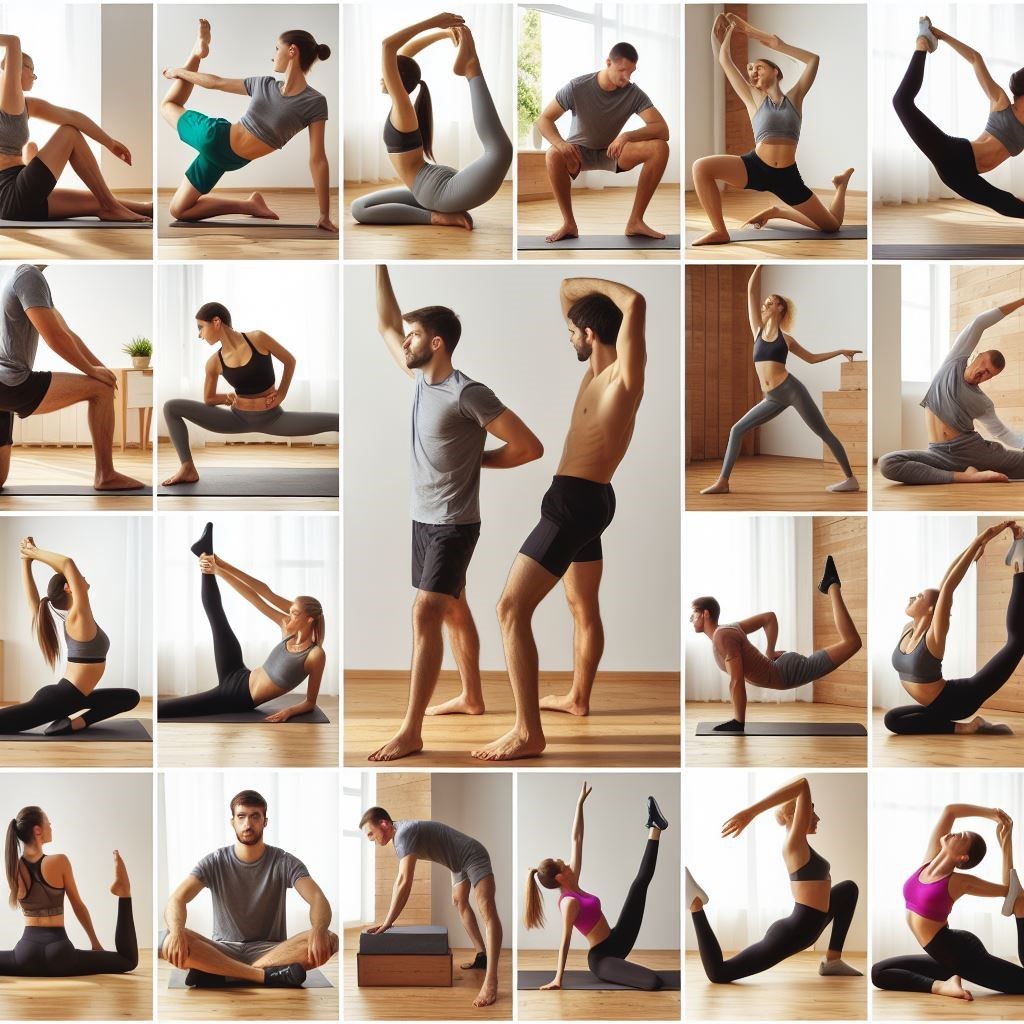
While not technically a hamstring exercise, stretching is important for flexibility and injury prevention. Perform these after workouts when muscles are warm.
Seated hamstring stretch:
- Sit on the floor with both legs straight out in front of you
- Lean forward from the hips to stretch the hamstrings
- Reach for toes and hold for 30-60 seconds
Lying hamstring stretch:
- Lie on your back, extend one leg straight up
- Bend the other knee and use your hands to pull the leg toward the chest
- Gently straighten the elevated leg until you feel a stretch in the hamstrings
- Hold for 30 seconds, then switch legs
Standing hamstring stretch:
- Stand with feet hip-width apart, knees slightly bent
- Lift one leg and place a foot on a stable elevated surface
- Lean hips forward until you feel a stretch in the raised leg hamstring
- Hold for 30 seconds before lowering and switching legs
Summary
There you have it – the top 12 hamstring exercises! Remember, these key points:
- Train hamstrings 2-3 times per week with 48 hours’ rest between sessions
- Mix up the planes of motion and unilateral/bilateral hamstring exercises
- Emphasize eccentric training for flexibility gains
- Moderate weight and higher reps build muscle; lower reps increase strength
- Warm up thoroughly and progress load gradually
- Prioritize form and full range of motion over weight used
- Stretch regularly to improve flexibility and prevent injury
Now that you’re armed with the best hamstring exercises, you can target this crucial muscle group for greater strength, aesthetics, and performance. Work those hamstrings and enjoy the gains!

